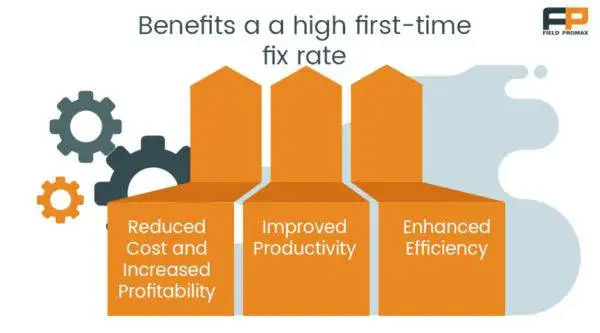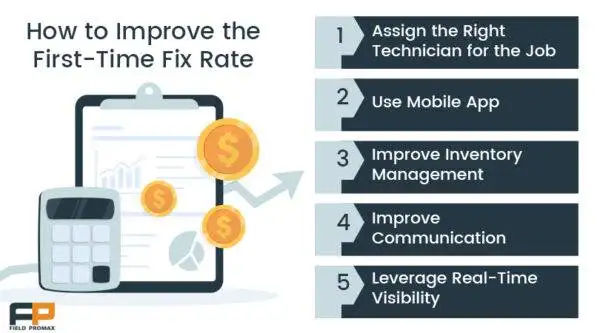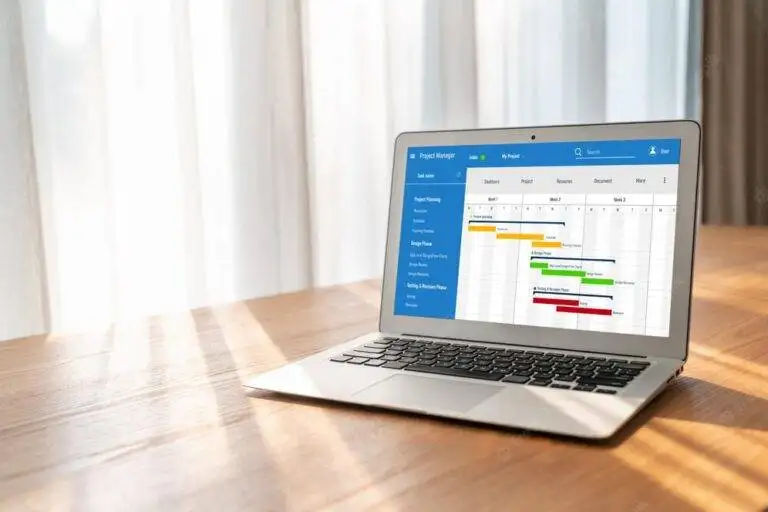5 Proven Ways to Improve Your First-Time Fix Rate

For any business, customer satisfaction holds the prime importance in determining a company’s growth. But when it comes to field service businesses, the stakes are higher than ever. To ensure sustainability, you need to make sure your customers are coming back to your brand, and telling friends and family about it when they are looking for the service you provide. None of this is going to happen if they are not satisfied with the job you have done.
To make that happen, it is not enough to do the job right. You’ll also need to do it right on the first try! In other words, to maintain customer satisfaction and customer retention, you need to improve your first time fix rate..
Ready to get started with Field Promax?
Sign Up FreeSo, if you run a field service business and business sustainability and growth are on your bucket list, you have no choice but to take measures to improve your first-time fix rates. But how do you achieve that goal?
If you are reading this blog, you have reached the right place. Here, you will find not one, but four actionable tips to improve your first time fix rate. Designed on the basis of the current best practices in the industry, these tips will also help you guide your field technicians to make the best use of the resources available and, thereby, provide the best-in-class service to the customers.
But before we go any further, let’s talk about the issue at hand and try to understand it a little bit more.
1. What is First-Time Fix Rate?
First-time fix rate, also known as FTFR, is a metric used to track how often tasks are completed on the first attempt. FTFR applies when a technician fixes a problem without requiring additional parts, data, information, or the assistance of specialists. It is also important to note that repeat visits and secondary call-outs cannot be included in this metric.
FTFR is an important maintenance KPI and business benchmark that reveals information about productivity and customer satisfaction. In order to fix problems the first time, technicians must arrive at the job site with the necessary skills and equipment. Without these two items, they will be required to leave the job site and return later to resolve the customer’s issue.
In the field service industry, the average percentage score for FTFR is 80%. Therefore, if your success rate is close to 90 percent, you should consider yourself a high achiever. If it is less than 70%, you may be jeopardizing the success of your organization.
2. How Do You Calculate the First-Time Fix Rate?
To determine the first time fix rate for your business, divide the number of jobs completed on the first visit by the total number of jobs. The end result is your FTFR. This calculation can also be used to evaluate the individual performance of employees on an individual level or for specific types of services. Moreover, this metric can help you determine where your technicians excel and where additional training is necessary.
In other terms, FTFR can be calculated using this simple formula:

3. What is A Good First-Time Fix Rate?
According to research, the average first-time fix rate for mobile service providers is 77.8%. However, the top-performing companies were able to maintain rates around 98%.
These numbers are mere approximations due to the vast differences between industry sectors and the various methods for determining rates. However, they provide a target for the types of rates that are realistically attainable.

4. Why is the first-time Fix Rate Important for Field Service?
When it comes to the customer experience in field service, the first impression can really make or break a business. This is due to the fact that 24% of clients who have a positive first impression will remain loyal for an average of two years. A negative interaction, on the other hand, causes customers to completely avoid your business.
You will only have one opportunity to impress new clients with your customer service. However, if the initial customer experience exceeds their expectations, you won’t have to. The best way to accomplish this is with a high first-time fix rate that ensures a positive first impression for your business.
Want a personalized demo?
See how Field Promax can transform your field operations
Today, customers place an emphasis on convenience. As customer experience expectations rise across all industries, the steep competition to provide convenience is fiercer than ever. And field service businesses are no different, perhaps even more so. Because a field service organization with a consistently low first time fix rate — where ‘poor’ is defined as ‘worse than the competition”—is likely to fail in the near future.
Why so? Because a low first-time fix rate is detrimental to the business, repeated service visits increase expenses, contribute to inefficient service engineer utilization, diminish customer confidence and satisfaction metrics, and result in price erosion.
Furthermore, a good first-time fix rate also has a direct impact on customer satisfaction. A recent study found that companies with an FTFR of more than 70% achieved an 86% customer retention rate, which is a direct result of your customer satisfaction rate (CSAT).
Knowing your CSAT score is important because keeping customers depends on how happy they are. CSAT, which stands for “Customer Satisfaction,” examines how well your customers think you’re doing. So, it’s very important to send out frequent surveys to get feedback from your customers. With this, you can improve your CSAT score and feel more sure about figuring out how FTFR really affects you.

Having a high CSAT score will affect your general bottom line. For instance, the best field service providers who got CSAT scores of 90% or higher were able to increase their profit margins by 30%. So, if you have a high first-time fix rate, you can expect to see a rise in customer loyalty. You can also expect other benefits, such as:
Reduced Cost and Increased Profitability
The higher your FTFR rate, the fewer site visits your field technicians have to make. This means that you will waste less time and money on expensive repeat visits. Also, by increasing your customer retention rate, a high first-time fix rate will also lower the amount of resources you have to spend on acquiring new customers.
Improved Productivity
Using FTFR as a key performance indicator (KPI) in performance evaluations will help you get more done in less time. By making sure problems are fixed the first time, workers will have more time to do other important things. If you free up your technicians so they can focus on first-time visits instead of repeat visits, you’ll be able to respond faster to future service requests.
Enhanced Efficiency
By getting high FTFR marks, you show clients that you care a lot about giving them good service. Better CSAT scores will also come from making your service work better. This makes it easier to retain customers while reducing the risk of losing them.
It is, however, one thing to know how poor first-time fix rates affect your business. It is a different aspect altogether when it comes to knowing what to do about it.
So, without further ado, let’s move on to the important issue at hand.

5. How Do You Improve the First Time Fix Rate?
Now that you know how to calculate your first-time fix rate and why it is absolutely significant for your business, let’s take a look at some of the most effective ways it can be improved.
i) Assign the Right Technician for the Job
Commonly, most field service companies are unable to fix a problem on the first visit because the technician sent to the job site is not adequately skilled for the job. You can easily avoid this by matching field technicians with the jobs for which they are best suited based on their skills, level of experience, and area of expertise.
Consider a scenario in which a customer calls an HVAC service company to repair a broken heating system, but the client does not know what the problem is and is unable to explain it over the phone. In this situation, it is best to dispatch an experienced HVAC technician who is confident enough to independently resolve the issue on-site. However, if a new technician shows up who lacks the necessary experience to handle the service call on their own, they would not be able to resolve the issue on the first try. They will need guidance, and, in some cases, assistance from a more experienced technician. Therefore, the HVAC company will need to dispatch a more experienced technician for a second visit.
If you are familiar with the skills and abilities of your technicians, you may be able to intuitively match them to jobs. However, as your business grows and you receive more calls, balancing technician scheduling and dispatching to meet customer demands will become a more challenging task. Implementing an HVAC business solution such as Field Promax reduces this burden by efficiently automating the process with functions such as skill matching and workload distribution.
ii) Use Mobile App
Inaccurate or improper problem diagnosis can result in severe downtime and poor FTFR. Without a clear and accurate diagnosis of the problem, workers may be required to return to the site. Therefore, getting the diagnosis right the first time will save you time, money, and a great deal of customer frustration.
The problem, on the other hand, is easy to solve if you give your technicians access to an integrated mobile app that lets them see historical data and information about work orders. Your FTFR will be enhanced by equipping your technicians with mobile devices that grant them access to:
- Asset/Work History
- Process and Workflow documentation
- Knowledge Management This will ensure they bring the right tools and equipment and allow for accurate documentation to safeguard your future FTFR.
iii) Improve Inventory Management
In the current business climate, competition is fierce. Therefore, you may lose a client if a competitor demonstrates that they can provide all the necessary components and you fail to deliver in that regard. No longer can technicians say, “We need to order a new part” and force the customer to wait another week. Obtaining the proper components for the job orders makes a significant difference. Therefore, if you want high first-time fix rates from your technicians, ensure seamless inventory management.
iv) Improve Communication Between the Office and the Field Technicians
Most of the issues a field technician faces while attending to a customer can be caused by wrong or inaccurate diagnoses of problems. In that case, they might have to go back to the spot if they can’t figure out what’s wrong in a simple and precise way. So, making the right decision the first time will save you time, money, and a lot of customer frustration. And this is only possible when your field technicians have a seamless communication channel with the office.
V) Leverage Real-Time Visibility
Dynamic team management is an essential component of efficient field service management today. It plays a pivotal role in increasing FTFR.
When your technicians are dispersed across multiple job sites, it is essential for them to communicate with one another. Even when technicians are perfectly matched with jobs, unanticipated obstacles such as a flat tire can force schedule adjustments. To provide excellent customer service and maintain a high FTFR, you must be flexible.
The GPS tracking feature of Field Promax provides dispatchers with real-time visibility into the location of technicians throughout the day. This means that if a technician is delayed at a job site or must leave work early due to a personal emergency, dispatchers will know precisely where the technician was on the route and how many jobs remain. It will be easy for dispatchers to switch jobs to technicians who have the right skills and can set up schedules.
Final Thoughts

While there is no single solution to magically improve your first time fix rate, these are some of the ways you can enhance your chances. However, as seen from the discussion, the easiest way to improve FTFR is to automate your business processes. Manual data entry, management, and paper-based methods involve a high risk of error, which could be fatal for your business. By automating your operation, on the other hand, you can rest assured that your processes are going to go seamlessly, increasing the chances of your technicians focusing on the actual job—getting the work done right on the first try.
Implementing work order management and scheduling and dispatching software, such as Field Promax, can improve your FTFR by automatically matching technicians to the most suitable jobs, allowing them access to job information and customer data, managing inventory, optimizing routes, tracking technicians in real-time, and much more.
For more information, contact Field Promax
We're here to help you get started